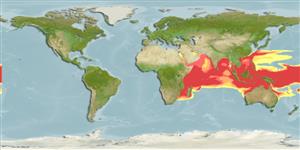Common names from other countries
>
Beloniformes (Needle fishes) >
Exocoetidae (Flyingfishes)
Etymology: Parexocoetus: Greek, para in the side of + Greek, exos = outside + Greek, koite = hole (Ref. 45335).
More on author: Valenciennes.
Environment: milieu / climate zone / depth range / distribution range
Ökologie
seewasser; ozeanodrom (Ref. 51243); tiefenbereich 0 - 20 m. Tropical; 30°N - 23°S, 20°E - 178°W
Indo-Pacific: widespread from East Africa, including the Red Sea and the Gulf, to southern Japan, Marshall Islands, Fiji, the Arafura Sea (Ref. 9819) and Queensland, Australia. Migrated to eastern Mediterranean through the Suez Canal (Ref. 6523). Presence in Somalia to be confirmed (Ref. 30573). Records from the Atlantic (as Parexocoetus mento atlanticus) are in error.
Size / Gewicht / Alter
Maturity: Lm ? range ? - 13 cm
Max length : 11.0 cm SL Männchen/unbestimmt; (Ref. 2797)
Rückenflossenstacheln (insgesamt) : 0; Rückenflossenweichstrahlen (insgesamt) : 9 - 12; Afterflossenstacheln: 0; Afterflossenweichstrahlen: 10 - 12. Dorsal fin mostly blackish; pectorals and caudal greyish, other fins transparent (Ref. 2797).
Found in near-shore surface waters, never spread to open sea (Ref. 9839). Capable of leaping out of the water and gliding above the surface (Ref. 30573).
Most die after a single spawning (Ref. 205).
Parin, N.V., 1996. On the species composition of flying fishes (Exocoetidae) in the West-Central part of tropical Pacific. J. Ichthyol. 36(5):357-364. (Ref. 27313)
IUCN Rote Liste Status (Ref. 130435)
CITES (Ref. 128078)
Not Evaluated
Bedrohung für Menschen
Harmless
Nutzung durch Menschen
Fischereien: weniger kommerziell
Tools
Zusatzinformationen
Download XML
Internet Quellen
Estimates based on models
Preferred temperature (Ref.
115969): 25.9 - 29.1, mean 28.5 (based on 4012 cells).
Phylogenetic diversity index (Ref.
82804): PD
50 = 0.6250 [Uniqueness, from 0.5 = low to 2.0 = high].
Bayesian length-weight: a=0.00646 (0.00292 - 0.01429), b=3.04 (2.84 - 3.24), in cm Total Length, based on LWR estimates for this (Sub)family-body shape (Ref.
93245).
Trophic level (Ref.
69278): 3.3 ±0.4 se; based on size and trophs of closest relatives
Widerstandsfähigkeit (Ref.
120179): hoch, Verdopplung der Population dauert weniger als 15 Monate. (Preliminary K or Fecundity.).
Fishing Vulnerability (Ref.
59153): Low vulnerability (10 of 100).
